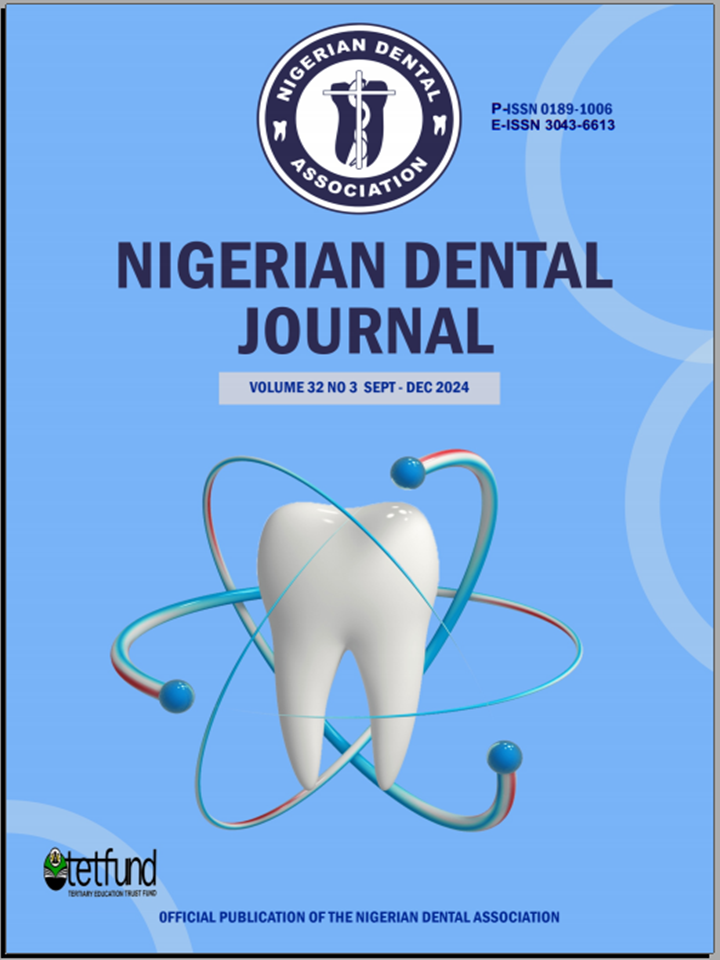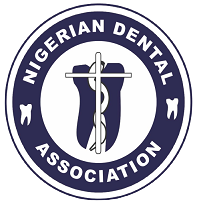Radiographic Study of the Prevalence and Pattern of Impacted Mandibular Third Molars in a Northern Nigerian Population.
DOI:
https://doi.org/10.61172/6sqx5z20Keywords:
Impacted teeeth, Panoramic radiograph, Third molarAbstract
Background: The incidence of impacted mandibular and maxillary third molars has become a global public health concern. This study reports a radiographic prevalence and pattern of impacted mandibular third molars among a Nigerian population.
Objectives: The aim of this study was to determine the prevalence and pattern of impacted mandibular third molars in a Northern Nigeria population.
Materials and Methods: This retrospective cross-sectional study was conducted at the Oral Diagnostic Sciences Department of the Aminu Kano Teaching Hospital Kano, Kano State, Nigeria. Digital diagnostic images of patients of record on Planmeca Promax® within the sampling frame and acquired during the two years under review, were included in the study. The images were analyzed on Planmeca Romexis 4.3.0 R software to identify relevant study variables. Descriptive statistics was done using SPSS for windows software version 23.0 (IBM, Chicago IL., USA). Also, Pearson’s Chi‑square (χ2) statistical test was applied while confidence interval and P-value were set at 95% and ≤0.05, respectively.
Results: A total of 4,932 pantomographs were reviewed and 576 were selected for the study. There were 824 impacted mandibular third molars within the age range of 18-65 years (mean age±SD = 32.67±9.69). 297 (51.6%) were males, and 279 (48.4%) were females. The prevalence of impacted mandibular third molar was 16.71%. Impacted mandibular third molar occurred more frequently in the 26-35 years age range. The most frequent angle of impaction was horizontal, followed by mesioangular, and the least frequent angulation was distoangular.
Conclusion: The prevalence and pattern of impacted third molars among Northern Nigeria population are almost similar to other racial populations with minor variations, and the prevalence decreases with increasing age. A proper radiographic evaluation of the patterns of third molars impaction is, therefore, essential to assist dental surgeons in making decisions with regard to surgical planning and treatment.
Key Words: Impacted teeth, panoramic radiograph, third molar.
Downloads
References
1. Pedro F, Bandéca MC, Volpato L, Marques A, Borba AM, Musis C de, et al. Prevalence of impacted teeth in a Brazilian subpopulation. The Journal of Contemporary Dental Practice. 2014;15(2):209–13.
2. Syed KB, Zaheer KB, Ibrahim M, Bagi MA, Assiri MA. Prevalence of impacted molar teeth among Saudi population in Asir region, Saudi Arabia–a retrospective study of 3 years. Journal of International Oral Health: JIOH. 2013;5(1):43.
3. Rantanan A. The age of eruption of third molar teeth. In: 44th ed. Acta Odontologica Scandinavica; 1974. p. 141‑5.
4. Ishihara Y, Kamioka H, Takano-Yamamoto T, Yamashiro T. Patient with nonsyndromic bilateral and multiple impacted teeth and dentigerous cysts. American Journal of Orthodontics and Dentofacial Orthopedics. 2012;141(2):228–41.
5. Braimah RO, Ndukwe KC, Owotade FJ, Aregbesola SB. Oral health-related quality of life (OHRQoL) following third molar surgery in Sub-Saharan Africans: an observational study. The Pan African Medical Journal. 2016;25(97):1–7.
6. Braimah R, Ndukwe K, Owotade F, Aregbesola S. Impact of oral antibiotics on health-related quality of life outcomes in Nigerian patients following mandibular third molar surgery. Nigerian Journal Clinical Practice. 2017;20(9):1189–94.
7. Khawaja NA, Khalil H, Parveen K, Al-Mutiri A, Al-Mutiri S, Al-Saawi A. A Retrospective Radiographic Survey of Pathology Associated with Impacted Third Molars among Patients Seen in Oral & Maxillofacial Surgery Clinic of College of Dentistry, Riyadh. Journal of International Oral Health. 2015 Apr;7(4):13–7.
8. Richardson ME. The etiology and prediction of mandibular third molar impaction. The Angle Orthodontist. 1977;47(3):165–72.
9. Obiechina A, Arotiba J, Fasola A. Third molar impaction: evaluation of the symptoms and pattern of impaction of mandibular third molar teeth in Nigerians. Tropical Dental Journal. 2001;24(93):22–5.
10. Winter G. Principles of exodontia as applied to the impacted third molar: a complete treatise on the operative technic with clinical diagnoses and radiographic interpretations. St Louis: American Medical Book. 1926;21–58.
11. Quek S, Tay C, Tay K, Toh S, Lim K. Pattern of third molar impaction in a Singapore Chinese population: a retrospective radiographic survey. International Journal of Oral and Maxillofacial Surgery. 2003;32(5):548–52.
12. Pell GJ, Gregory GT. Report on a ten-year study of a tooth division technique for the removal of impacted teeth. American Journal of Orthodontics and Oral Surgery. 1942;28(11):B660–6.
13. Haddad Z, Khorasani M, Bakhshi M, Tofangchiha M. Radiographic position of impacted mandibular third molars and their association with pathological conditions. International Journal of Dentistry. 2021;2021.
14. Hashemipour MA, Tahmasbi-Arashlow M, Fahimi-Hanzaei F. Incidence of impacted mandibular and maxillary third molars: a radiographic study in a Southeast Iran population. Medicina Oral, Patologia Oral y Cirugia Bucal. 2013;18(1):e140.
15. Hattab FN, Ma’amon AR, Fahmy MS. Impaction status of third molars in Jordanian students. Oral Surgery, Oral Medicine, Oral Pathology, Oral Radiology, and Endodontology. 1995;79(1):24–9.
16. Eliasson S, Heimdahl A, Nordenram Å. Pathological changes related to long-term impaction of third molars: A radiographic study. International Journal of Oral and Maxillofacial Surgery. 1989;18(4):210–2.
17. Rajasuo A, Murtomaa H, Meurman JH. Comparison of the clinical status of third molars in young men in 1949 and in 1990. Oral Surgery, Oral Medicine, Oral Pathology. 1993;76(6):694–8.
18. Montelius G. Impacted teeth: a comparative study of Chinese and Caucasian dentitions. Journal of Dental Research. 1932;12(6):931–8.
19. Hassan AH. Pattern of third molar impaction in a Saudi population. Clinical, Cosmetic and Investigational Dentistry. 2010;109–13.
20. Morris CR, Jerman AC. Panoramic radiographic survey: a study of embedded third molars. Journal of Oral Surgery (American Dental Association: 1965). 1971;29(2):122–5.
21. Alhadi Y, Al-Shamahy HA, Aldilami A, Al-Hamzy M, Al-Haddad KA. Prevalence and
pattern of third molar impaction in sample of Yemeni adults. Online Journal of Dentistry and Oral Health. 2019;1(5):1-4.
22. Muhamad AH, Nezar W, Azzaldeen A. Prevalence of impacted mandibular third molars in population of Arab Israeli: A retrospective study. IOSR Journal of Dental and Medical Science. 2016;15:80–9.
23. Hugoson A, Kugelberg C. The prevalence of third molars in a Swedish population. An epidemiological study. Community Dental Health. 1988;5(2):121–38.
24. Ma’aita J, Alwrikat A. Is the mandibular third molar a risk factor for mandibular angle fracture? Oral Surgery, Oral Medicine, Oral Pathology, Oral Radiology, and Endodontology. 2000;89(2):143–6.
25. Kim JC, Choi SS, Wang SJ, Kim SG. Minor complications after mandibular third molar surgery: type, incidence, and possible prevention. Oral Surgery, Oral Medicine, Oral Pathology, Oral Radiology, and Endodontology. 2006;102(2):e4–11.
26. Brown L, Berkman S, Cohen D, Kaplan A, Rosenberg M. A radiological study of the frequency and distribution of impacted teeth. The Journal of the Dental Association of South Africa= Die Tydskrif van die Tandheelkundige Vereniging van Suid-Afrika. 1982;37(9):627–30.
27. Haidar Z, Shalhoub SY. The incidence of impacted wisdom teeth in a Saudi community. International Journal of Oral and Maxillofacial Surgery. 1986;15(5):569–71.
28. Aitasalo K, Lehtinen R, Oksala E. An orthopantomography study of prevalence of impacted teeth. International Journal of Oral Surgery. 1972;1(3):117–20.
29. Sandhu S, Kaur T. Radiographic evaluation of the status of third molars in the Asian-Indian students. Journal of Oral and Maxillofacial Surgery. 2005;63(5):640–5.
30. Blondeau F, Daniel NG. Extraction of impacted mandibular third molars: postoperative complications and their risk factors. Journal of the Canadian Dental Association. 2007;73(4):325.
31. Almendros-Marqués N, Alaejos-Algarra E, Quinteros-Borgarello M, Berini-Aytés L, Gay-Escoda C. Factors influencing the prophylactic removal of asymptomatic impacted lower third molars. International Journal of Oral and Maxillofacial Surgery. 2008;37(1):29–35.
32. Al-Anqudi SM, Al-Sudairy S, Al-Hosni A, Al-Maniri A. Prevalence and pattern of third molar impaction: a retrospective study of radiographs in Oman. Sultan Qaboos University Medical Journal. 2014;14(3):e388.
33. Eshghpour M, Nezadi A, Moradi A, Shamsabadi RM, Rezaer N, Nejat A. Pattern of mandibular third molar impaction: A cross‑sectional study in northeast of Iran. Nigerian Journal of Clinical Practice. 2014;17(6):673–7.
Downloads
Published
Issue
Section
License
Copyright (c) 2024 Abdulmanan YAHAYA, Mohammad Abubakar KAURA, Bernard Emeka OGBOZOR, Ka’abu Abdulrazak ADAM, Alufohai OLOHIGBE, George EWANSIHA, Babatunde Olamide BAMGBOSE

This work is licensed under a Creative Commons Attribution 4.0 International License.
Open Access Statement
- We became fully Open Access since January 2023.
- Our new and archived materials are available free of charge on open basis and under a Creative Commons license as stated below.
Copyright statement
Copyright © 1999 The authors. This work, Nigerian Dental Journal by Nigerian Dental Association is licensed under Creative Commons Attribution 4.0 International License.


